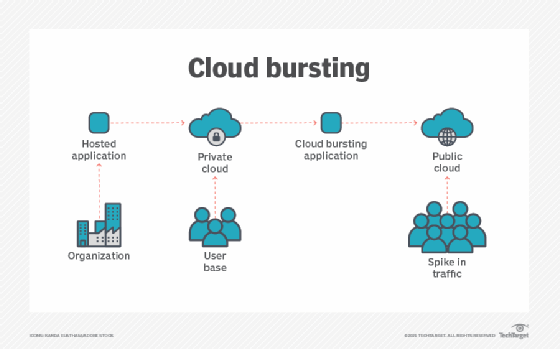What is cloud bursting?
Cloud bursting is an application deployment technique in which an application running in a private cloud or data center bursts its extra workload to a public cloud when the demand for computing capacity spikes. This deployment model gives an organization access to more computing resources as needed.
When compute demand exceeds the capacity of a private cloud, cloud bursting gives an organization additional flexibility to deal with peaks in IT demand and frees up local resources for other critical applications.
The advantage of a hybrid cloud deployment model like cloud bursting is that an organization only pays for extra compute resources when they are needed.
In a cloud bursting model, the private cloud is the primary means of deployment, with public cloud resources being used in times of increased traffic. When a private cloud reaches its resource capacity, overflow traffic is directed toward a public cloud without service interruption. Once reduced to normal traffic levels, data is moved back to the private cloud. Cloud bursts can be triggered either automatically based on high usage demands or manually by request.

When using cloud bursting, an organization should consider its level of security, platform compatibilities and compliance requirements. Because private clouds are generally more protected than public clouds, critical applications or data are not recommended for cloud bursting since that data will transition between clouds, potentially introducing security and compliance risks.
How does cloud bursting work?
IT administrators help establish capacity thresholds for applications in the private cloud. When workload capacity nears its threshold, the used application automatically switches to the public cloud and traffic is directed toward it. Once the spike in resource demands diminishes, the application is moved back to the private cloud or on-premises infrastructure.
An organization can take one of the following approaches to cloud bursting:
Distributed load balancing. With distributed load balancing, applications operate between a public cloud and a data center. When traffic hits its predefined threshold, an identical environment redirects workload traffic to a public cloud. This method needs an application to be deployed locally and in the public cloud and requires load balancing operations to share traffic.
Pros: This method is highly scalable, promotes high availability, optimizes performance and is cost-efficient.
Cons: Data consistency can be challenging. More endpoints can mean more security risks or a larger attack surface. Configuration can be complex, requiring specialized knowledge.
Automated bursting. This method requires an organization to set policies to define how bursting is handled. Once set, an application hosted in a private cloud can automatically burst over to a public cloud. Software is used to automatically switch the application over. This helps an organization provision cloud resources exactly when needed without delay.
Pros: This method offers elastic scalability, cost and operational efficiencies, enhanced performance and availability. Automated cloud bursting can improve the resilience of applications and services.
Cons: Data latency issues can affect performance, integration can be difficult, configuration can be complex, and automated scaling can cause costs to spike.
Manual bursting. Manual bursting enables an organization to manually provision and de-provision cloud services and resources. It is suitable for temporary large cloud deployments when increased traffic is expected or to free up local resources for business-critical applications.
Pros: This method's costs are predictable. It offers greater resource control, enhanced security, and a lower risk of unauthorized data transfer.
Cons: This method takes longer to scale compared to automated methods. It requires human intervention for resource allocation and management. There can be increased operational costs and inconsistencies in process management.
When does an organization need cloud bursting?
Cloud bursting is recommended for high-performance, noncritical applications that handle nonsensitive information. An application can be deployed locally and then burst to the cloud to meet peak demands, or it can be moved to the public cloud to free up local resources for business-critical applications. Cloud bursting works best for applications that do not depend on a complex application delivery infrastructure or integration with other applications, components and systems internal to the data center.
When considering cloud bursting, an organization must also examine security and regulatory compliance requirements. For example, cloud bursting is often cited as a viable option for retailers that experience peaks in demand during the holiday shopping season. However, cloud computing service providers do not necessarily offer an environment compliant with the Payment Card Industry Data Security Standard, and retailers could be putting sensitive data at risk by bursting it to the public cloud.
Other applications of cloud bursting include the following:
- Software development and big data modeling. Organizations that handle big data or machine learning can use cloud bursting to generate models that exceed their private cloud capacity.
- Marketing campaigns. An organization can use cloud bursting with a marketing campaign if they are expecting a large influx of traffic as a result.
- Healthcare. Data-intensive research can benefit from on-demand high-performance computing.
- Retail and e-commerce. Overflow traffic due to seasonal sales can be rapidly and inexpensively accommodated without permanent infrastructure investment.
Cloud service providers Amazon Web Services, Google Cloud and Microsoft Azure can support cloud bursting.
The benefits of cloud bursting
The main benefits of cloud bursting include the following:
- Cost. An organization only pays for extra compute resources when needed. Likewise, private cloud infrastructure costs can be kept low by maintaining only minimal resources.
- Flexibility. Cloud bursting can quickly adjust to capacity needs and free up private cloud resources.
- Business continuity. An application can burst over to the public cloud without interrupting its users.
- Peaks in traffic. If an organization is expecting a sudden increase in traffic, like during a holiday, cloud bursting can be used to facilitate any expected or unexpected peaks in compute resource demands.
The challenges of using cloud bursting
Cloud bursting does come with some challenges, however. These include the following:
- Security. If a public cloud is attacked, then an adjacent organization's data can be at risk.
- Data protection. It could be difficult to keep backups consistent when they are fed from multiple sources.
- Networking. Organizations might find it difficult to build low-latency and high-bandwidth redundant connections between public and private clouds.
Other issues related to cloud bursting arise from the potential for incompatibility between the different environments and the limited availability of management tools. Cloud computing service providers and virtualization vendors have developed tools to send workloads to the cloud and manage hybrid environments, but they often require all environments to be based on the same platform. These challenges typically lead to few companies being able to deploy cloud-bursting architectures.
How to implement a cloud bursting strategy
The following are some tips for implementing a cloud bursting strategy:
- Assess use cases. Determine how cloud bursting could be beneficially applied in the enterprise.
- Choose an appropriate architecture. Identify the primary environment and select the right architecture to accommodate the use cases.
- Choose a cloud provider. Determine which of the cloud providers can best handle the burst traffic.
- Decide between automated and manual bursting. Make appropriate monitoring and personnel choices based on this decision.
- Implement security. Apply in-transit encryption; configure roles, access and authentication.
- Implement monitoring. Configure resource triggers, such as CPU usage and memory management, and establish ongoing usage monitoring.
- Configure scaling. Define appropriate scaling policies and implement triggers as needed.
Learn more about how cloud bursting works and which applications can benefit from it.







